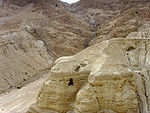Ghassulian refers to a culture and an archaeological stage dating to the Middle and Late Chalcolithic Period in the Southern Levant (c. 4400 – c. 3500 BC). Its type-site, Teleilat Ghassul (Teleilat el-Ghassul, Tulaylat al-Ghassul), is located in the eastern Jordan Valley near the northern edge of the Dead Sea, in modern Jordan. It was excavated in 1929-1938 and in 1959–1960, by the Jesuits. Basil Hennessy dug at the site in 1967 and in 1975–1977, and Stephen Bourke in 1994–1999.The Ghassulian stage was characterized by small hamlet settlements of mixed farming peoples, who had immigrated from the north and settled in the southern Levant - today's Jordan, Israel and Palestinian territories. People of the Beersheba culture (a Ghassulian subculture) lived in underground dwellings, a unique phenomenon in the archaeological history of the region, or in trapezoidal houses of mud-brick. Those were often built partially underground (on top of collapsed underground dwellings) and were covered with remarkable polychrome wall paintings (one of the most notable examples being the 'Ghassulian Star'). Their pottery was highly elaborate, including footed bowls and horn-shaped drinking goblets, indicating the cultivation of wine. Several samples display the use of sculptural decoration or of a reserved slip (a clay and water coating partially wiped away while still wet). The Ghassulians were a Chalcolithic culture as they used stone tools but also smelted copper. Funerary customs show evidence that they buried their dead in stone dolmens and also practised secondary burial.Settlements belonging to the Ghassulian culture have been identified at numerous other sites in what is today southern Israel, especially in the region of Beersheba, where elaborate underground dwellings have been excavated. The Ghassulian culture correlates closely with the Amratian of Egypt and also seems to have affinities (e.g., the distinctive churns, or “bird vases”) with early Minoan culture in Crete.








